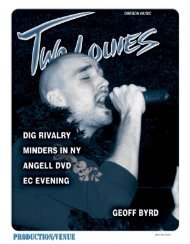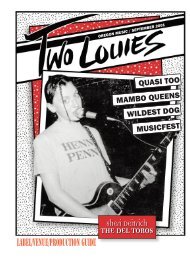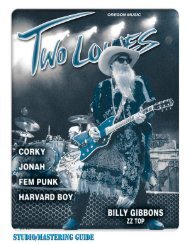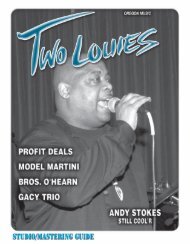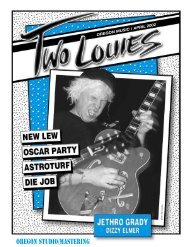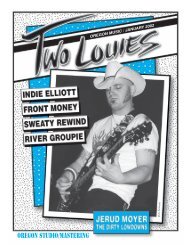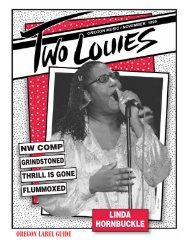2L April 99 Studio - Two Louies Magazine
2L April 99 Studio - Two Louies Magazine
2L April 99 Studio - Two Louies Magazine
You also want an ePaper? Increase the reach of your titles
YUMPU automatically turns print PDFs into web optimized ePapers that Google loves.
Continued from page 10<br />
cal gold, utilizing well-planned arrangements and<br />
magical production choices. They are obvious students<br />
of the crafts of writing and producing Rock<br />
music. They are tapped into the wellspring of genius<br />
at the fountain of inspiration drinking down all that<br />
their minds and souls can possibly hold.<br />
Advance EP— Kaitlyn Ni Donovan<br />
Self-Produced<br />
It’s been five years already since Kaitlyn Ni<br />
Donovan first appeared on the scene, with a penchant<br />
for unique, ethereal song suites and hauntingly beautiful<br />
vocal presentations. Some believed she would<br />
have found wider success by now, with her unusual<br />
style. But Kaitlyn has taken a somewhat longer road.<br />
Regardless. As evidenced by the three advance tracks<br />
included among the four on this EP, she is clearly at<br />
the threshold of achieving the recognition to which<br />
her rare musical gifts had always given so much promise.<br />
Kaitlyn has surrounded herself with a deep pool<br />
of auxiliary talent including, among several others,<br />
guitarist Jonathan Drews and bassist Eric Furlong—<br />
who, between them, have played in a bazillion bands<br />
in their five or so years in the local scene; as well as<br />
production god Tony Lash, whose contribution here<br />
is immeasurable. The result is a gloriously original<br />
sound which might be categorized as falling somewhere<br />
between Sarah McLachlan, the Cocteau Twins,<br />
Loreena McKennit and Portishead in the grand celestial<br />
scheme of musical things. But Kaitlyn’s sound<br />
is singularly her own, derived from her “morphed”<br />
chord progressions on guitar and Celtic influences<br />
on the violin. She is one of a kind.<br />
“Ceiling Tiles” begins with a drum loop, slightly<br />
compressed to resemble Portishead’s style, as grumbling<br />
guitar sounds whir mechanically into the frame.<br />
Kaitlyn enters with gentle acoustic guitar arpeggios,<br />
while amorphous sounds formlessly hover in the<br />
sonic æther. Suddenly a green rain of mournful Celtic<br />
violins cascade upon the scene. A moody electric piano<br />
paces the landscape beneath. As Kaitlyn begins<br />
to sing, the instruments receding into the mist, only<br />
the piano and her guitar to guide her as the drum<br />
loop clocks relentlessly in the spatial distance; her<br />
voice a vaporous honey whisper. This song would be<br />
perfect soundtrack material for Jane Eyre<br />
orWuthering Heights.<br />
Glistening mandolins dance like snowflakes in<br />
Page 24 - TWO LOUIES, <strong>April</strong> 1<strong>99</strong>9<br />
the moonlight on “Tiny Twigs.” A soaring dove of a<br />
violin glides among the heavens, Kaitlyn’s angelic<br />
voice hushing a sweet lullaby from above. Hypnotically<br />
resonant, similar to portions of Terry Riley’s<br />
minimalist epic In C. Simply beautiful. Acoustic and<br />
electric guitars weave a sonorous brocade on “Awake<br />
In The Sand,” Kait’s delicate voice tripping lightly<br />
across the flimsy fabric. A melancholy cello passes<br />
through the chorus and bridge, as layers of sumptuous<br />
harmonies choir in divine resplendence.<br />
The home recorded “Wingside” hearkens to<br />
Kaitlyn’s beginnings, but demonstrates precisely the<br />
evolution this EP represents. For she has lived up to<br />
the challenge of channeling her extraordinarily phenomenal<br />
propensity for melody. A voice for the new<br />
millennium, exquisitely ephemeral, magically enchanting.<br />
Kaitlyn Ni Donovan may have taken the<br />
long road on her journey to discover the means to<br />
her own musical expression. But with this recording,<br />
there is no doubt that she has indeed at last arrived at<br />
her destination.<br />
I Go Zoom— Mary Kadderly<br />
Mary Margaret Music<br />
Mary Kadderly has sung out in the vibrant local<br />
Jazz scene for many years now, regularly gigging with<br />
pianist Steve Christofferson in a duo format for several<br />
of them. Here they are joined by a stellar sidecrew,<br />
to create a refined Pop sound, with smooth Jazz undertones.<br />
Kadderly can, with facile zeal, sing rings<br />
around <strong>99</strong>.9% of her competition. Her easy contralto<br />
effortlessly navigates a wide swath of musical styles—<br />
so diverse, it is difficult to describe exactly from which<br />
“Jerry Hahn’s peerless tone, unmistakable when it<br />
appears in the mix, supports a fluid Jazz-savvy fret<br />
technique that is a complete education for anyone<br />
who might fancy himself to be a guitarist.”<br />
bag she may be actually coming. But every stylistic<br />
guise she dons seems as if it were one she has worn all<br />
her life.<br />
And talk about a sterling backup band! All nine<br />
songs overflow with big name players, including<br />
Christofferson on a variety of keyboards, drummer<br />
Jeff Minnieweather and Joey Seifers on electric and<br />
standup bass. Dan Faehnle alternates lead guitar<br />
chores with the legendary Jerry Hahn whom, in every<br />
instance, gives rise to a profound sense of wonder<br />
and astonishment at his marvelously subdued and<br />
constrained approach to the instrument. His peerless<br />
tone, unmistakable when it appears in the mix,<br />
supports a fluid Jazz-savvy fret technique that is a<br />
complete education for anyone who might fancy himself<br />
to be a guitarist. This guy is a master.<br />
As if that were not enough honey in the mead,<br />
Valerie Day adds percussion to a number tracks, while<br />
guitarslinger Trooper Tim Ellis makes several appearances<br />
in an auxiliary role, fleshing out zesty rhythms<br />
on acoustic guitar in some parts, comping faithfully<br />
on electric in others. Trumpeter Paul Mazzio and<br />
saxman Lee Wuthernow sweeten a number of cuts.<br />
Even violinist Skip Parente sits in on a tune.<br />
A few of the songs are well-enough crafted to<br />
seem like standards or, at the very least, standardsto-be.<br />
Kadderly had a hand in the writing of all the<br />
songs, creating a varied palate of melodies for the intelligent<br />
poetry of lyricists Todd Schultz and Brett<br />
Bender, as well as for a several of her own verses.<br />
Schultz, especially, distinguishes himself in his two<br />
lyric contributions, with an actual and distinctive style<br />
of writing that is literary in its construction, intellectually<br />
incisive and emotionally perceptive.<br />
For the most part though, the aural focus is on<br />
the stalwart musicianship that drips from every tune.<br />
Christofferson kicks off the title track with swinging<br />
boogie piano licks, as Kadderly delivers a light lyric<br />
with a smooth and assured vocal with a great sense<br />
timing and energy. “Someday Sometime” is a pretty<br />
ballad, a little predictable lyrically, but with a sophisticated<br />
arrangement that calls to mind some of Jim<br />
Webb’s most memorable songs.<br />
“Sea Of Love” funks things up in a mellow way:<br />
kind of like a toned down version of Steely Dan’s<br />
“Parker’s Band,” Christofferson’s Hammond chattering<br />
and purring in the foreground. Hahn fires off a<br />
staccato onslaught of well-aimed notes in a brilliant<br />
solo that touches all the bases in the process of hitting<br />
it out of the park.<br />
“It’s Not Over Yet” couples Day’s spicy bongos<br />
with Minnieweather’s hip-hoppy drum patterns<br />
against Seifers’ satisfying standup bass— as Mary<br />
throws down a space age vocal melody over Faehnle’s<br />
Wes Montgomery flavored guitar voicings. Schultz’<br />
clever lyric adds to the sensually charged atmosphere,<br />
creating a rich tension in its own right. “Can You Feel<br />
It” play’s on the traditional Bo Diddly rhythm, adding<br />
New Orlean’s juju with Christofferson’s chunky<br />
Hammond and stride colorations on piano.<br />
The piece de resistance of the set is the is the<br />
marvelous torch ballad “Love Is Losing,” where Hahn<br />
is allowed to showcase his incredible skills. Over a<br />
quiet Jazz trio scenario: Minnieweather massaging his<br />
snare with gentle brushstrokes; solid underpinning<br />
by Seifers on standup bass, Hahn layers ghostly chords<br />
behind Kadderly’s smoldering vocal. She wraps her<br />
voice around a supple marriage of her classic melody<br />
and Schultz’ inspired lyric: “Fact or fiction/You decide/So<br />
we’re in love/Somehow that’s not enough/You<br />
were so real/Now you dodge and conceal/Dead love<br />
is cruel/I’m a memory fool/Love is losing, it’s the end<br />
of the ride.” Hahn’s flawless timing and graceful phrasing<br />
is as supple as fine leather. Trumpeter Mazzio casts<br />
a lovely Jazz-blue light upon his wonderful solo,<br />
stretching each note with confident luxuriousness.<br />
To front a collection of pros such as these requires<br />
that a singer have a lot of fortitude and considerable<br />
chops— just to keep the listener’s attention<br />
from straying too far into the background: to explore<br />
the awe-inspiring instrumental terrain. Mary<br />
Kadderly never fails to remain at the center of the<br />
session displaying versatility and appeal at every turn.<br />
This album is a tremendous showcase for her quite<br />
significant skills. She meets every musicalchallenge<br />
with complete style and class.<br />
LL



